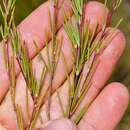en
names in breadcrumbs


Aspalathus linearis is a brushy legume (family Fabaceae) with needle-like leaves that grows only in the fynbos ecosystem in the western Cederberg region of South Africa.Despite many attempts to cultivate A. linearis elsewhere, this has not succeeded, perhaps because of the symbioses the legume forms with specific nitrogen-producing bacteria it harbors in its well-developed root nodule system and because of specific adaptations to its microclimate.
The plant grows as a straggly sub-shrub, between 1.3-2 meters tall.It has a long taproot, red branches, and grows clumps of typical legume-shaped yellow flowers and downy pods containing tiny, hard, bean-shaped ant-dispersed seeds.
Aspalathus linearis is known as rooibos, meaning “red bush.”It's leaves have long been collected by local people from the hills on which the plant grows, processed by crushing and dried, and used to prepare “bush tea” or “rooibos tea.”Roobios tea grew in popularity in South Africa especially starting in the 1930s when Oriental black tea was difficult to obtain during world war II.At this time, locals started cultivating the plants in small suitable areas.Since then, it has become an important international export worth millions. The industry is currently the largest year-round and seasonal employer in rural South Africa and many independent farmers also now depend on selling harvesting and selling wild rooibos.
In addition to its use as a beverage, rooibas tea is prescribed for calming digestive disorders and various stomach problems, reducing nervous tension, and alleviating allergies. It is used also for topical treatment of dermatological diseases. Analysis of rooibos tea indicates that it is low in caffeine and tannins, and rich in volatile compounds, polyphenols, and minerals, and has antioxidant activity attributed to the flavonoids and phenolic acids it contains.
Precious Ramotswe, the Botswanan protagonist of novelist Alexander McCall Smith’s New York Times Bestselling “No. 1 Ladies Detective Agency” series, regularly drank “bush tea,” and reflected on it as a refreshing beverage; this spiked a demand for rooibos tea world wide starting in the 1990s.
Aspalathus linearis species has important ecological, economic, and cultural significance.Because it requires a very specific, small and sensitive habitat, and bioclimatic modeling indicate that rooibos may suffer from detrimental effects of climate change, Lötter and le Maitre (2014) emphasize a urgent necessity to closely manage this species in order to protect wild populations and sustain its cultivation.
(Bramati et al. 2002; Lötter and le Maitre 2014; Morton 1983; Wikipedia 2014)